The moments before a dive are often awkward. I waddle across the stern of the boat, laden with heavy gear, my feet stupid with rubbery fins. A swell threatens to topple me. A lone eagle, seeking amusement, soars across from the jungled volcanic shore of New Britain, one of Papua New Guinea’s outlying islands. Then I step out towards the sea.
The Guardian’s product and service reviews are independent and are in no way influenced by any advertiser or commercial initiative. We will earn a commission from the retailer if you buy something through an affiliate link. Learn more.
The transformation is immediate and electrifying: all sense of blundering clumsiness is banished – well, most of it at least. I can see fish below and an edge to the coral, beyond which all is darkness. Most of all I am breathing, and continue to do so as I sink gently towards that reef, through a shoal of barracuda, a scattering of graceful angelfish and stern-faced giant trevallies. And then I hover, a metre above the fantastic array of colour and life: knobbly gaping blue sponges as big as Ali Baba’s jars, vast skeletal forms of Gorgonian fans, a clown triggerfish with bee-stung yellow lips and harlequin decoration. No experience available to humans is quite like this. You enter a realm in which you have no place, a realm more weird and wonderful, I suspect, than anything in outer space.

The idea of swimming for extended periods below the surface may have become normalised, but it is a recent phenomenon, and largely came about through the efforts of one man: Jacques-Yves Cousteau. From the 1940s, he co-developed the aqualung, pioneered underwater photography, kick-started underwater archaeology, discovered thousands of precious sub-sea sites and witnessed scenes no human being ever had1. Most of all, he inspired a love of the oceanic world in millions of people, and a desire to see that world protected. He was a titan. If he had sprouted wings and discovered flight, he could not have done more to open up a new dimension to humanity. Now a new film, The Odyssey, released on 18 August in the UK, will tell the tale of the man’s astonishing life.
Underwater, Cousteau said, man becomes an archangel. Eighteen metres below the waves, I’m not exactly feeling angelic, but I am in a state of bliss. I follow my dive buddy Willy across the coral surface to the edge, where it abruptly disappears into the blue depths. Down there sharks occasionally loom. This is Inglis Shoal, a gigantic plug of coral rising from the floor of the Bismarck Sea, home to hundreds of creatures, many unknown to science. It was in these waters that Cousteau, then in his 80s, took his last dive.
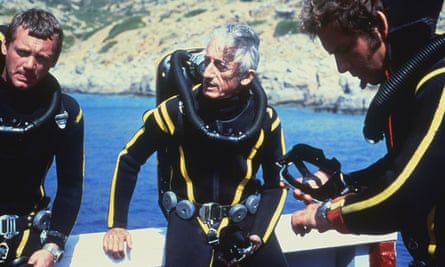
We drop down the side of the mount, mesmerised by the array of life. In this world even the slug is a gorgeous show-off, a Royal Ascot darling in silky purple and yellow. Nearby, under a spreading shade of coral, two sharp-suited shadows cruise lazy circles – a pair of baby reef sharks, oozing miniature menace. I turn and spot an adult effortlessly rising from the gloom below. Mother? We leave them in peace.
That afternoon, back on land, I meet Max Benjamin, an Australian agriculturalist who came to New Britain in 1966 to manage a new palm oil plantation. “I soon realised that the reefs in the bay were pretty special,” he says, “I went diving in the Red Sea, which was touted as the world’s best diving in those days, and thought, ‘Kimbe Bay has got much more’.”
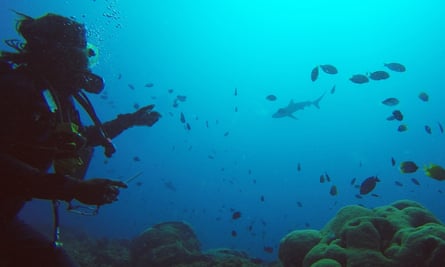
His response was to set up Walindi Plantation Resort and word-of-mouth recommendations in the diving community brought visitors, among them Cousteau. “The Calypso, Cousteau’s legendary ship, anchored right here in 1987.”
It was the start of a process that led to recognition of Kimbe as a vital central element in the Coral Triangle, an area bounded by Indonesia, the Philippines and Papua New Guinea, and the world’s primary marine biodiversity hotspot. “Cousteau was an old man by then,” says Benjamin, “but he inspired me to set up a research institute, Mahonia Na Dari.”
That institute has become a powerhouse for international marine biology, but also for educating and inspiring local people to understand and value the marine world. A stay at Walindi, I discover, offers chances to meet all kinds of interesting folk: doctorate students discovering how reefs work, photographers, and Professor Peter Buston from Boston University, who holds me spellbound with tales of the brutal, fantastical world of the clownfish. “As larvae they can detect the smell of a certain tree leaf, one that grows on coral islands, and they swim for up to 10 days continuously until they find that island.”
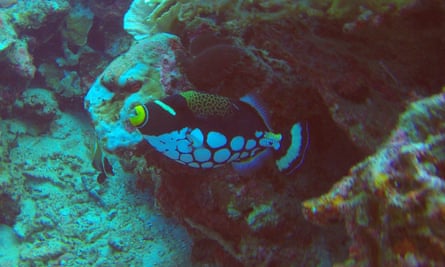
Peter and other researchers have shown how clownfish live in strict hierarchies, each maintaining the appropriate bodyweight and sex for their grade. Top gun is the dominant female, who evicts any insubordinate underlings – and eviction means certain death.
The future of this complex environment is much-debated now: with rising sea temperatures come bleaching and reef death. Two PhD students explain to me: “Recently El Niño has caused large masses of warmer water to move across the Pacific towards New Guinea, but so far they have been deflected south and hit the Barrier Reef.” They are researching how some fish survive such events, others not. Like many here, they mention Cousteau as an inspiration.
On the fringe of this group of biologists there is a quiet local man, Joseph. Is he a diver? He chuckles. “I was,” he says, “but I got cooked.” That turns out to be diver jargon for the dreaded bends. It had happened many years ago, but brought his diving career to an end. With that came a new departure. “I’d always been interested in birds so I began taking people out. Want to go?”

“It’s night.”
Joseph grins. “I can show you a very rare bird.”
Twenty minutes later we are cruising the grassy lanes that mark boundaries inside the palm oil plantation. The crop vilified by western environmentalists is popular here. “We can get five crops a year,” says Joseph, “Plus jobs, plus the biomass generators produce power.”
There are regular courses for local students and an outreach programme that gets to about 7,000 children annually
Not only that: the controversial monoculture also harbours an avian rarity. We stop to admire a pair of trees that are lit up by fireflies, all blinking in unison like a set of Christmas lights. “It was here we found it,” says Joseph. “Sitting on that post. No one had seen one since the 1980s and people were thinking it was extinct.”
We drive on, but our rarity does not appear. Only when we hit the asphalt road again does Joseph screech to a halt. “He’s there – up in that tree.”
I get out the car and just have time to spot a flicker of movement, then a yellowish bird, barn-owl size, flits away.
“Golden masked owl,” says Joseph, beaming proudly. “A New Britain endemic. Now rediscovered.”
Next day the research institute near my cabin is busy with a group of primary school teachers on a training course. There are also regular courses for local students and an outreach programme that gets to about 7,000 children annually, spreading the message of marine conservation. That prompts me to notice an absence – of people selling shells at the resort gate – something all too predictable elsewhere. In 1987, when Cousteau visited, his marine organisation, the Cousteau Society, noted the potential threats to Kimbe Bay: boat damage to reefs, spearfishing, over-fishing, shell-collecting, and dynamiting of the reef. Already in evidence, they stated, was some sediment damage from forest clearance.
Fortunately, those threats have not materialised, partly because diving tourism has brought a source of wealth to this remote outpost – all the divemasters and boat captains I met were local – and provided a compelling argument for conservation. A then unforeseen danger, however, now fills many people around Kimbe Bay with dread: rising sea temperatures. So far the area has escaped any consequences, but its reefs, home to half the coral species found in the entire Indo-Pacific region, are undoubtedly vulnerable.
On my last dive we head out across the bay, then cut in close to shore under the volcano. Oscar, the boatswain, checks the GPS carefully and then we roll overboard.
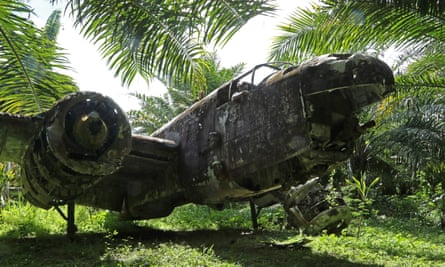
I’ve done several dives now and the clumsy movements are almost gone. We begin our descent and almost immediately a shape appears below, that of a fighter plane, a Japanese Zero from the second world war. It has a single propeller whose rotors are not twisted, a sign that it was no longer spinning when the aircraft hit the water. I drop directly on to the wreck’s tail fin and begin to work my way up the fuselage. Some delicate sponges, yellow with purple lips, adorn the aluminium. Willy gestures for me to join him at one wing tip. He points underneath. There is a gigantic lobster there, glaring.
On the back of the cockpit, a lovely pale pink anenome waves silkily in the current
Kimbe Bay, like a lot of Papua New Guinea, has its share of second world war litter. Fierce battles scattered wreckage and pollution across the islands, beaches and oceans. In the jungle close to Walindi Resort is a well-preserved B-25 bomber, and other planes and ships are dotted around. The Zero fighter had been ditched by the pilot who escaped and swam ashore. No doubt it spewed kerosene and was a localised pollution disaster but now, when I move up to the cockpit, I find it full of tiny fish and corals. A brilliant blue wrasse explodes past me. On the back of the cockpit, a lovely pale pink anenome waves silkily in the current. In its soft folds a small world of clownfish has taken root. I watch carefully, remembering what Peter Buston had told me. They will be here, as individuals, for up to 30 years, never more than a few centimetres from home, each waiting patiently for a promotion up the hierarchy.
The weapon of war and pollution hotspot has, I see, become a clownfish base. It’s a result that fills me with hope. Cousteau himself said that humans had made the sea a garbage can, but he remained optimistic that we could surmount the problems we have created: “If we were logical, the future would be bleak, indeed. But we are more than logical. We are human beings, and we have faith, and we have hope, and we can work.” Let’s hope he is right.
Way to go
The trip was provided by the Papua New Guinea tourist board. Dive Worldwide has tailor-made diving trips to Papua New Guinea: a 20-day trip in two centres, Kimbe Bay and Tufi, is £5,595, including all flights, meals and dives. Philippine Airlines flies to Port Moresby from Heathrow from £751 return, including free stopover accommodation in Manila. The most useful reef guide I found in Walindi’s impressive library was Indo-Pacific Coral Reef field guide by Allen and Steene; it seems to be out of print but Abebooks should locate it. Birds of New Guinea is a good recent guide on the subject.
JACQUES COUSTEAU’S TOP DIVE SITES
Sipadan, Malaysia
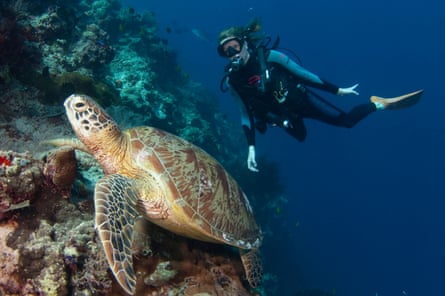
Cousteau used this island, off the east coast of Sabah, in his 1989 documentary film The Ghost of the Sea Turtle and declared, “We have found an untouched piece of art.” Turtles abound and there are more than 3,000 marine species in what is a living coral colony growing on top of a volcanic cone. Currents are strong and experience necessary. There’s also a Foreign Office warning to consider.
borneodivers.info
Aliwal Shoals, South Africa
Three miles offshore and prone to some big swells, Aliwal is not for the weak of stomach. However, the rewards are great, especially during the sardine migration between July and November when hordes of tuna, dolphin, whales and sharks pass through. It is particularly noted for ragged tooth and tiger sharks.
diveworldwide.com
Sea of Cortez, Mexico
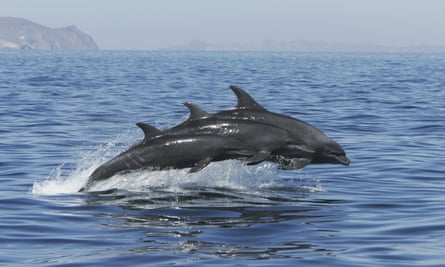
Some Cousteau discoveries – Richelieu Rock in Thailand, for example – are not what they once were. The fact is that diving must be done sensitively: inexperienced divers can break coral, fish are scared away, anchors can cause mayhem. One Cousteau favourite that is still a superlative site is the Sea of Cortez with its whale sharks, manta rays, bottlenose dolphins and, during February to April, grey whales.
dive-the-world.com
Sha’b Rumi, Sudan
South of the well-known Sinai dive sites, Sudan has excellent, unexplored diving. Cousteau chose this spot for his experiments into underwater living that featured in his 1964 film, World Without Sun. Sharp currents bring huge quantities of fish, along with sharks, including hammerheads and silkies.
sudan-diving.com
Coron Bay, Philippines
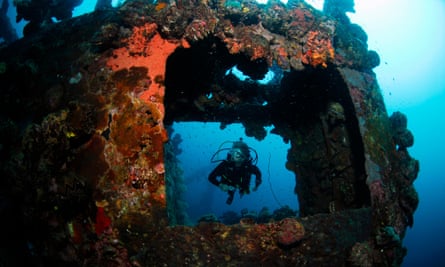
Cousteau declared the north Palawan islands “the last great wilderness” and used it for a late film, The Last Refuge (1992). The star attraction is Coron Bay, where an entire Japanese fleet was sunk by devastating US air attacks in 1944. A good base is Sangat, a spectacular uninhabited island with a dive resort close to all the classic wreck dives.
diveworldwide.com

Comments (…)
Sign in or create your Guardian account to join the discussion